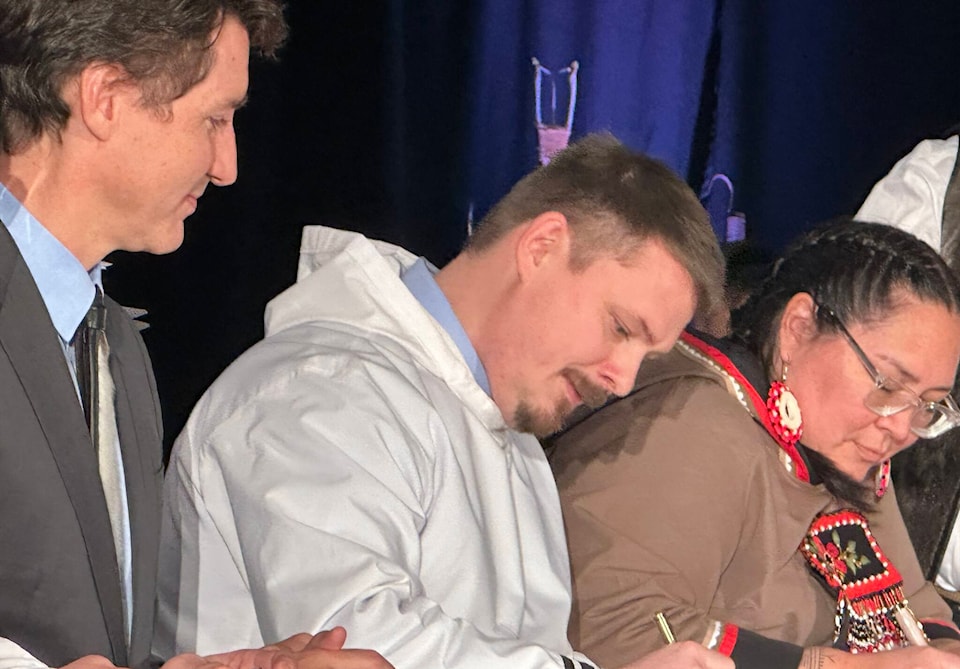It was 1999, I was 14 years old, the draw was between my best friend and me. Like most teenage boys we were fiercely competitive, wanting to best each other at every turn. But this one was a big one.
We were in Ausuittuq (Grise Fiord). I had joined the Canadian Junior Rangers to try new things and learn new skills, but also because it came with opportunities for travel. I loved my tightknit community, but like most young people I was eager to visit new places and meet new people.
The leader explained that only one of us could go to Iqaluit as a Junior Ranger for the celebration. At the time, I didn’t grasp the historic importance of the event, but I knew it was something big, and I didn’t want to miss out.
In the end, it was my friend who got picked.
Like most Canadians, I watched the official ceremonies of Nunavut becoming a territory on television. I saw Premier Paul Okalik shaking Prime Minister Jean Chrétien’s hand, surrounded by a sea of Inuit. That moment had a profound impact on me. Seeing my territory and my people on national television, seeing the pride on the faces of our leaders, and the hope on the faces of Inuit.
In many ways, the creation of our territory shaped the trajectory of my career. I wanted to play a role in growing Nunavut, our land.
On Jan. 18, 2024, I was honoured to join Prime Minister Justin Trudeau and Nunavut Tunngavik Incorporated President Aluki Kotierk to sign the Nunavut Lands and Resources Devolution Agreement.
As I was shaking hands with the prime minister and NTI president, I was brought back to that day in 1999 and the impact it had on me. I thought about my own kids watching. I thought about all the other young people across our territory experiencing this historic moment on large screens in school gymnasiums and auditoriums. I hoped that young Nunavummiut felt the excitement and inspiration to achieve great things and strive for a better future, as I had as a teen.
Nunavut has matured and prospered over the past 25 years. We have shown Canada, and the world, the balance between Inuit Qaujimajatuqangit and contemporary systems of governance. We operate as a consensus government. Our political structure is led by the societal value of Aajiiqatigiinniq: decision-making through discussion and consensus.
As members of the legislative assembly, we sit in a circle — reminiscent of a qaggiq — to find common ground on the decisions that shape our territory. It is a humbling process, but it has shown to strengthen us as leaders and as a territory.
I have seen our communities grow and prosper. We have diversified our economies with new opportunities in various sectors, from mining to fisheries to renewable energy. We have shown the world that a balance can be achieved between environmental stewardship and conservation, and economic prosperity. In a few years, as we implement the devolution agreement, all decisions about our land, resources and waters will be made at home rather than in Ottawa.
There is still much work to be done as we continue to build our territory. Many Nunavummiut are living in overcrowded or poor-quality homes. Providing safe and secure housing for everyone in Nunavut will require Qanuqtuurniq, the Inuit societal value of being innovative and resourceful.
As we speak, housing projects have started across the territory, piles are in the ground and homes are taking shape. By partnering with Inuit development corporations, we are building three times more houses at half the cost. We are finding innovative and resourceful solutions.
Today, I see young Nunavummiut stepping up to advance our territory. Our youth are achieving excellence in the arts, commerce and trades, science and technology, governance and law. It will be the innovations of the next generation of Nunavummiut that will shape our territory’s future.
I am inspired by a vision of our territory that has a thriving, sustainable and diversified economy. A territory that is fueled by green energy, strengthened by a resilient legal and governance system, and celebrated through a vibrant made-in-Nunavut arts and cultural scene. I see resilient communities fortified by adequate housing and critical infrastructure. This is the Nunavut that I look forward to celebrating at our 50th anniversary, shoulder to shoulder with the new visionary leaders who helped bring it to fruition.
—P.J. Akeeagok is the premier of Nunavut.
